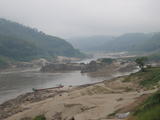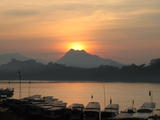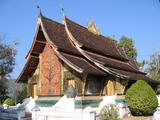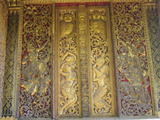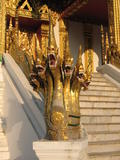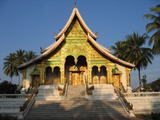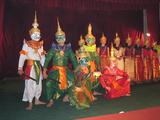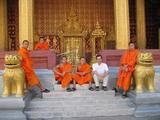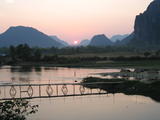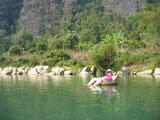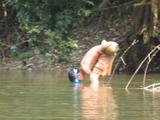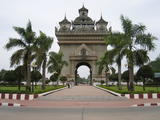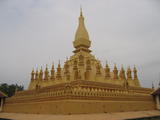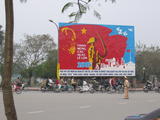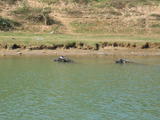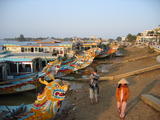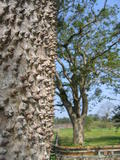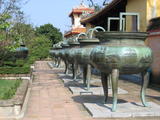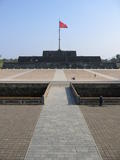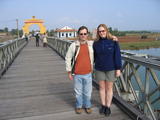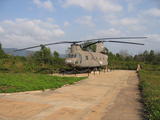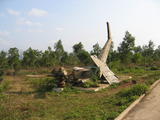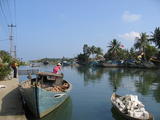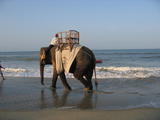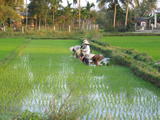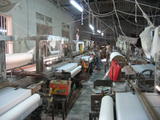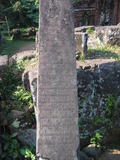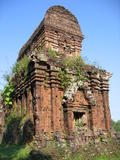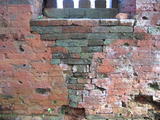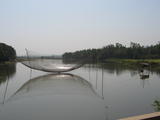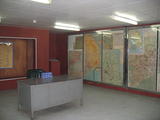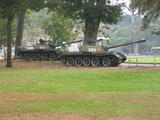| < < < Previous story | Next story > > > | |
Laos and VietnamBandar Seri Begawan, 16 March 2005
Contents:LaosAfter having celebrated New Year in Chiang Mai, we crossed the Mekong river into Laos at the Chiang Khong/Houei Sai (Huay Xai) border crossing. From where a two day boat ride down the Mekong river took us to the historic Laotian town of Luang Prabang. The Mekong is still a wild river with many rocks protruding from the water making navigation difficult. There is hardly any human habitation along the river, the mountains are covered with forest, but very little wildlife seems to be present. The absence of birds, apparently because everything that moves is killed and eaten, is striking once it is pointed out. Some of the forest looks like it is growing on fields that are no longer used. "Looks like all the poppy fields have unfortunately gone" was the explanation of a fellow traveler! Luang Prabang is a beautiful town with temples on every street. The town is currently undergoing a facelift, many streets are being tastefully redone. Luang Prabang is bound to become a major hit with tourists in the coming years, we may have been there just in time to still be able to take photos without busloads of tourists. One of the first things that strikes a visitor to Laos is the friendliness of its people. It is really indescribable, you just feel it. The only downside is that things close down early, even hotels close their doors before midnight. Traveling from Luang Prabang towards the capital Vientiane we stopped in the small town of Vang Vieng. Although the town is really nothing to write home about, it is a very relaxed and incredibly cheap place (a decent double room goes for 4 to 5 USD). The main attractions are the surrounding landscape of karst mountains, caves to explore and a shallow river to float down in. They will drop you off a few kilometers upstream, with just an inner tube. While slowly drifting down you can buy drinks and snacks from little stalls along the river. When you want something they will hold out a bamboo stick for you to hold on to so they can pull you in. Tubing here is a stressless experience. If you stayed long enough in Vang Vieng you could really wind down. Vientiane, was somewhat disappointing after Luang Prabang and Vang Vieng, it has two or three things to see and do. We spent 1 day there, but you could see it all in one afternoon and quickly move on. VietnamOur first impressions of Vietnam were terrible! It started with the overnight bus trip from Vientiane to Hué, which was sold as the "direct VIP" bus to Hué. It certainly was not a VIP bus. At around 01:00 at night the bus made a food stop, when we went back to the bus, everyone had mysteriously disappeared except us and some other foreigners. At 06:00 they reappeared, apparently they had all gone sleeping somewhere and nobody told us anything! Nice. After crossing the border, our "direct" bus to Hué drove north towards Hanoi, which was the wrong direction for us. They intercepted a south-bound local bus, to which we had to change. That bus was of even worse quality. When we finally approached Hué the bus stopped 6 kilometers short of our destination. They told us to get off and take a taxi from there. There was no taxi, so we refused to get off the bus. When a taxi finally did show up it asked 40 U.S. Dollars!!! Acting as if this was a perfectly normal price, they started to take our bags off the bus, but we held on to them, refusing to get off yet again. After nearly a day in crappy buses we were not too happy about this situation and the way they were trying to take us for a ride. So we played it hard, telling them, that we had already paid for the bus ticket to Hué and if they felt that we needed to do part of that already paid for trip by taxi, it was for them to pay for the taxi. After some arguing the bus continued to another turn off where they intercepted another taxi, which was willing to do it for 40,000 Dong (about 2.60 US Dollars). The bus driver even gave us the money for the taxi! The taxi driver asked us where we wanted to go so we gave him the name of our hotel. He said that he knew where it was, but once in Hué he stopped in front of another hotel and declared that we had arrived in the center. We disagreed of course because it was not our hotel. He then wanted another 40,000 Dong to bring us to our hotel (which was less than 1 kilometer away). This did not come unexpected as we had been forewarned by other travelers to Vietnam who experienced the same problem. I made it clear to him that he would not get a single Dong from us if he did not bring us to our hotel. After more wasted time, he finally agreed to bring us there, but demanded that we pay first. I asked him if he really thought we were that stupid? Unfortunately we were lied to and deceived many other times. They are able to lie to your face in ways that I had not thought possible, on one occasion they told everyone in an already full bus that we had to change to a bigger bus. Yet the bus we had to change to was a lot smaller and everyone was crammed into it. Bus trips in Vietnam are horrible, besides the bad quality of the buses, suicidal and asocial driving habits, every driver honks continuously. Not that anyone in Vietnam ever reacts to the sound of a horn. The horns are uncomfortably loud making a lot of noise inside the bus as well. The drivers must be deaf. When one vehicle passes another, a symphony of horns takes place, since this happens continuously earplugs are a must when taking a bus in Vietnam. We soon got to hate buses so much that we switched to using the more expensive train service. But that also had its downside. We shared a compartment with two young Swiss girls, one of whom went to the toilet in the middle of the night without waking anybody up. Somebody locked her into the toilet and that person proceeded to enter our compartment while we were all asleep. The thief stole about 18 Euros worth of Vietnamese Dong from Maris' bag. These and other incidents caused us to treat people with suspicion, never being able to fully trust them. But that is not all, sometimes one had to be downright harsh and unfriendly, in order to get them to deliver what was promised (as with the taxi driver). This state of mind makes traveling in Vietnam less pleasurable than in the other countries in the region, so when we left Vietnam there was little trace of the sadness we usually experience when leaving a country. In spite of the nasty undertone set by these incidents, there have still been some enjoyable and interesting moments in Vietnam. Our first stop in Vietnam was after all the historic city of Hué, which with the palace in the old center and the imperial tombs along the river has a lot to offer. An excursion in a "dragonboat" along the river to these sites is a very nice way to spend a day. Another long but interesting day trip from Hué is a visit to the former DMZ. The de-militarized zone between North and South Vietnam was established in 1954 when France, the former colonial master of Vietnam, ceded North Vietnam to Ho Chi Minh after having been humiliatingly defeated in the battle of Dien Bien Phu. Of the initial 15,700 French troops, some 4,500 died in the battle and around 10,800 were taken prisoner (of which only 3,300 were returned alive). I had expected an anti-American rant from the guide, but this did not materialize. Instead he matter of factly explained that after Vietnam had been divided in two, the North attacked the South and that the Americans came to help the South in order to fight the "commie people" as he called them. He continued to explain that in 1975, two years after the last US troops left Vietnam, the South was overrun by North Vietnamese troops. He added that US troops never invaded North Vietnam. It became even more interesting when he talked about present day Vietnam. There is only one party in Vietnam, "unlike in your countries". When there are elections all candidates belong to the communist party. Before 1990 when the economy was still communist monthly rations consisted of 7 kilograms of rice and 1/2 a kilogram of meat, but now with the free market there is enough food for everybody, there is now actually so much food that Vietnam has become a major rice exporter. At the memorial for North Vietnamese victims, I asked him whether there are any memorials for South Vietnamese victims. He replied: "No, because they lost." Amongst the relics of the war that we visited were the Vinh Moc tunnels, just north of the DMZ, said to be better preserved then the more famous Ku Chi tunnels near Saigon. Another site was the Khe Sanh combat base, south of the DMZ, where I bought a dog tag of a former U.S. soldier named C.P. Thompson. But it could just as easily be a fake. The base was on the frontline with North Vietnam and was one of the first to fall to the North during the war. Nothing remains of the base, there is now a museum and some old U.S. military hardware. Back in Hué we enjoyed some truly tasty food, as they have developed an appetizing mixture of Indochinese and French cuisine in this part of Vietnam. We ate in several up-market restaurants (quite affordable for foreign tourists). After Hué, Hoi An was the next town we visited. It is a charming little town with many old style houses still intact and even more excellent restaurants than in Hué. In one restaurant we had to laugh when the waitress told us that "chicken has flu today". We could not resist to ask if she thought that the chicken would be better tomorrow... There is a nice beach 5 km east of Hoi An which is easily accessible by bicycle (which you can rent everywhere in town). Another attraction near Hoi An is the old Champa ruins of My Son, a kind of miniature Angkor. Unfortunately during the American war (as they call the Vietnam war in Vietnam) the Viet Cong used it to hide in and the site got bombed. A few bomb craters are still visible. The bombing ended when president Nixon was made aware of the historical value of the site by a French archaeologist and ordered the bombing to stop. An interesting feature of the My Son temples is the way the bricks are stuck together. There is no space between the bricks and they stick together without cement. According to the guide this remains one of the biggest mysteries of My Son. The bricks also do not become moist even after a thousand years, while the bricks used in restorations do. Our last stop in Vietnam was Saigon (officially renamed Ho Chi Minh City, but most people still seem to refer to it as Saigon) where one can visit the former Presidential Palace of the republic of South Vietnam and the War Remnants Museum, which used to be called the Museum of American War Crimes. Both places are now hotbeds of North Vietnamese propaganda, the museum exposes lengthily on crimes committed by U.S. and South Vietnamese troops. Most of the photos and documents on display are actually of American origin. The museum is silent about North Vietnamese misdeeds. I was quite surprised by the level of criticism some people dared to express, at least in the south. Sometimes it was quite subtle as one man told us, that his wife was a communist but he did not believe in politics (i.e. he was not a communist). An elderly Saigon citizen told me: "If you have power over me, and you tell me that that plant is a chicken, I will agree with you." He had spent some time in a reeducation camp after the collapse of the South Vietnamese state in 1975. The contrast with China where people tow the official party line without a trace of criticism is striking. Which leads to the expectation that Vietnam may well become democratic before China. One more incident I would like to share with you happened during a bus stop along the road. I heard a bark, when I turned around I saw a truckload of caged dogs pass, caged like pigs being driven to a slaughterhouse! I was shocked! If you would like to be notified or no longer want to be notified of our travel updates please e-mail me. e-mail Otto de Voogd PhotosLuang PrabangVang ViengVientianeHuéDMZHoi AnSaigonPractical Information
To my knowledge the information provided here was accurate
at the time of our visit. However time passes and things can change.
Visas
Laos:
You can get a 15 days visa upon arrival by air or at the
land borders with Thailand for 30 USD and 1 passport photo.
You can also pay 1500 THB,
which is equivalent to 37.5 USD, so bring 30 USD.
There is no need to arrange a visa before hand, unless you want to
stay more than 15 days.
Money
Laos: There are no ATMs, except in Vientiane,
where the one we saw
was out of order. The official exchange rates seems to be about 30%
lower than the cash rate so there is a risk that you may get less Kips for
your money using an ATM anyway.
Bring cash US Dollars or alternatively Thai Baht.
Both are accepted everywhere.
The local currency, LAK, is only used for food and local items, hotels
and tourist transport are quoted in USD or sometimes THB, but may be
paid in LAK, sometimes at a good and sometimes at a bad exchange rate.
The Euro does not fetch a good exchange rate (you lose 9%).
Transport
Laos: Boats on the Mekong in the North
can be pleasant but sometimes overcrowded.
Buy tickets at the port, not through agents. Do not believe
anybody who tells you there may be no place left on the boat, in true South
East Asian fashion there is always place for one more person on the boat.
Buses are not great.
Annoyances
Laos: Things close down early, hotels even lock their doors
before midnight.
CostsLaos - Kips, approx. rates: 1 USD = 10,360 LAK, 1 EUR = 13,675 LAK (Based on the cash exchange rate for the US Dollar). The Thai Baht (THB) is also widely accepted in Laos. Approx. rates 1 USD = 39 THB, 1 EUR = 52 THB.
Small boat across the Mekong from Chiang Khong in Thailand
to Houei Sai (Huay Xai) in Laos: 20 THB
Vietnam - Dong, approx. rates: 1 USD = 15,750 VND, 1 EUR = 20,500 VND
Laos border guard "overtime payment" (on Saturday and Sunday): 1 USD or 10.000 LAK.
| ||
| < < < Previous story | Next story > > > | |
New | About | Contact | Connect | Friends | Promotions | Copyright | Advertise

